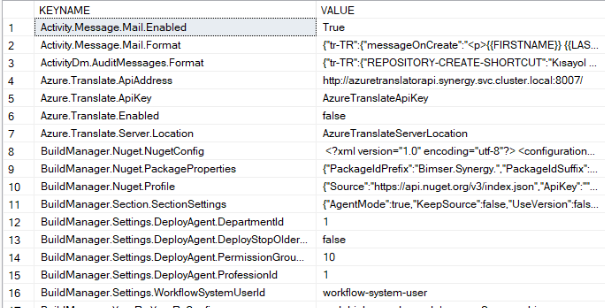System tables
CONFIGURATIONS Table
A configuration table is a table that shows the configurations and settings of the system in an organized manner.
This table helps determine how the system components are put together and which features are active.
It is used to keep track of the current status of the system and any necessary changes.
In a project, a configuration table is used to effectively provide configuration and parameter management on the server side.
For example, we can evaluate this table as a Web.Config.
Using the web.config file, we can edit the configuration settings and customize the way the system works according to the need.
There are two columns named KEYNAME and VALUE.

Examples of Table Usage;
DataSource.Connections.Default.DataSourceID;**
A CSP connects to a data source so that it can process data effectively. A configuration key, such as datasource.connection.default.id that data source is the databases that the system depends on, determines which default data source the application uses.
As VALUE, the UID value is taken from the IMCONNECTIONS table and added to the relevant row.
In this way, the system knows from which data source the user will select the query written on the datasource.

Language.Section-sys.UserCanChange;
Using KEYNAME, we can determine whether the user can change their language.
True/false values given to the VALUE column allow the System Administrator to manage based on the value entered.

MailService.Section-sys.DefaultMailAddress;
The MailService.Section-sys.DefaultMailAddress switch is used to determine the configuration of the application's mail mail services.
This key defines the default e-mail address of the system and specifies the address to be used during e-mail sending.
MailService.Section-sys.Profiles
The MailService.Section-sys.Profiles key is a configuration element that defines configuration profiles for mail services.
Contains the connection information required for sending mail
You can find detailed information for the definition of Mail Integration in the link below.
<https://docs.bimser.net/docs/Synergy/CSP/integration/Mail%20Entegrasyonu/```>```

These examples give a general idea of how the configuration table can be used.
You can experiment with such examples in your test environments to delve deeper into similar applications and details.